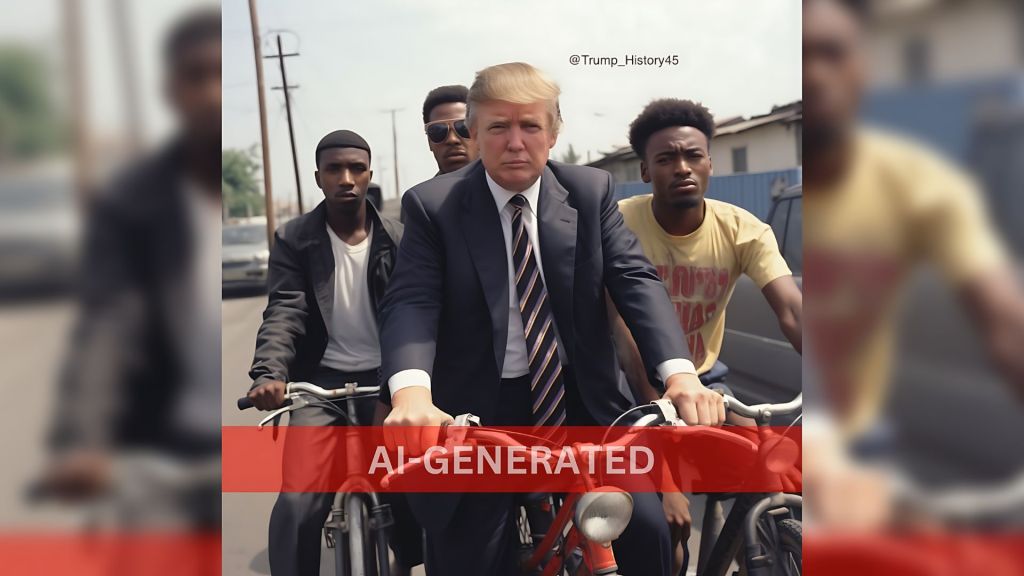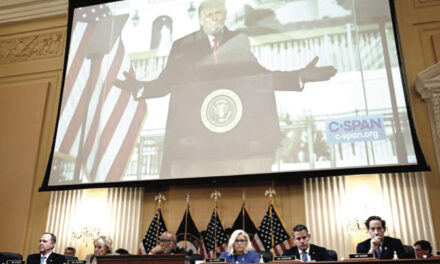By Angelina Hicks and Vani Sanganeria
New York Amsterdam News

Credit: Photo courtesy of amsterdamnews.com
As the U.S. enters its first presidential election in which convincing misinformation can be created by artificial intelligence (AI), supporters of former President Donald Trump are spreading AI-generated images of him posing with Black celebrities, historical figures, and ordinary Black people.
Trump backers often used the fake images to illustrate and amplify a genuine trend: polls showing growing, although still modest, support for Trump among Black voters.
Some of the photos, which can look strikingly real, began as parodies but ended up being used for political persuasion in posts viewed by millions of people. At least one photo was used in a dubious fundraising scheme by a person purporting to be a top Trump advisor.
The New York Amsterdam News has identified AI-generated images by using a variety of established methods, including running the images through AI image detection tools. Our methods can be found here.
In 2020, only about 12 percent of Black voters cast their ballots for Trump, according to exit polls—the lowest among any major ethnic group. But last fall, the New York Times trumpeted a poll conducted with Siena College that found 22 percent of Black voters in swing states would support Trump this time around. While the results suggest growing support for Trump among Black voters, only 403 Black voters were polled from the six swing states, making it hard to draw firm conclusions.
The NYT poll was followed by one from NBC News showing that 20 percent of Black voters would consider supporting Trump, although it included only about 120 Black people.
Despite their limitations, these polls received widespread attention. Not long after the NYT poll was released, internet personality and conspiracy theorist Dom Lucre, who has 1.2 million followers on X, posted an AI-generated image of Trump marching in a huge crowd of Black men. The caption read, “President Trump can’t lose” because he has “n*****” backing him in this election. The post was viewed more than 11 million times.
The same image—this time with a grayscale filter—was also posted by Vernon Jones, a former Georgia state representative and vocal Trump supporter with more than 633,000 followers on X. He posted, “We’re coming, and we’re bring Black MEN voting with us!” The image was viewed more than 83,000 times.
Lucre and Jones did not respond to requests for comment.
Diara Townes, a research consultant for the Disinfo Defense League, said such posts show an intent to “reverse reality” and sway Black voters.
“When you see AI images being produced from a party that doesn’t normally get that kind of support, you can see that the intent is to basically revise reality,” Townes said.
Two days after the NBC poll, a Trump-focused account on X with more than a million followers posted NBC’s headline superimposed on an AI image of Trump grinning in a crowd of smiling Black men.
That account, @PapiTrump, says it engages in parody. Most of its posts appear to support Trump, and the account was reportedly popular among followers of the QAnon conspiracy theory. The person or people behind @PapiTrump could not be reached for comment, but the post with the real headline on the phony photo racked up more than 200,000 views. Replies showed that while some people recognized the photo as fake, others apparently did not.
“Awesome pic! Beautiful smiles,” said one reply.
“Imagery can make things feel more real, more palpable, more vivid,” said Kurt Sampsel, who focuses on disinformation and community engagement at PENAmerica. “I think that that is a big part of what’s going on here.”
A new riff on an old theme
While generative AI is new, Black voters have been targets of election disinformation campaigns time and time again. A U.S. Senate report found that Russian interference in the 2016 election mainly targeted Black voters in an attempt to divide the U.S. electorate and encourage more support for Trump.
In 2020, two right-wing political operatives launched a robocall campaign designed to keep Black voters in New York, Ohio, and other states from voting. The calls falsely warned voters that mail-in voting would reveal their personal information to police departments and credit card companies. In connection with that scheme, Jacob Wohl and Jack Burkman pleaded guilty to a felony fraud charge in Ohio and were fined more than $5 million by the Federal Communications Commission, among other penalties.
Some of today’s most widely spread AI-generated images of Trump weren’t created by foreign actors or clearly identifiable political operatives. Instead, many originated from accounts labeled as satire.
One of the most prominent is @Trump_History45, or Trump History, which has accounts on X, Instagram, Facebook, Telegram, and Truth Social, with the X account having the biggest following—of more than 142,000 followers. Since its first post in August, the account has been run anonymously, but the Amsterdam News discovered that Trump History is owned and operated by Joseph Perez, a social media coordinator for PragerU, a popular conservative media organization with more than 2.2 million followers on Instagram that has featured prominent right-wing figures such as Tucker Carlson and Candace Owens.
The Amsterdam News matched a residential address associated with Perez to the address listed on Trump History’s merchandise website. Perez declined an interview in an email to the Amsterdam News and did not respond to a list of questions, but he wrote, “I suppose I have to update the merch store! I didn’t know that you can see my personal info there!”
In an email, a spokesperson for Prager said it is not affiliated with the Trump History account “in any capacity.”
Brogan Wassell, who used to work with Perez at PragerU as an “AI-integration consultant,” said in an interview with the Amsterdam News that he collaborated with Perez on Trump History.
Wassell said Perez owns and runs the account, adding that he had trained Perez in Midjourney, a popular AI imagery tool, and had also generated several images on the Trump History account himself.
“There’s a sort of symbiotic relationship that happened, because I joined Prager to integrate AI tools into the pipeline at the company,” Wassell said in an interview with the Amsterdam News. “I looked over at what Joe was making, because I’m also active on Twitter in the AI community, and I noticed one of the images that had been generated by was on the Trump History account.
“I put two two together, and I walked over to his office, and I was like, ‘Nice job,’” Wassell said.
Trump History posts AI-generated images of Trump as Santa Claus, Trump with Harry Potter, and Trump as the first man on the moon. The account also posts less fantastical AI-generated images of Trump with Black people, often engaged in activities like posing outside, walking in a march, or eating a meal together. Often, Perez captions images that depict Trump with his Black “supporters” or “homies.”
Wassell described Perez as the “ideas guy” behind the account, which took off when right-wing political influencers such as Jack Posobiec and the Krassenstein brothers started retweeting their images.
In one post of Trump posing with a thumbs up in front of a group of Black people, some dressed in traditional African attire, Trump History captions the image, “Donald Trump takes a photograph with his supporters outside of the Fulton County Jail – August 24th, 2023.”
A Trump History image of Trump holding up a fist next to Black men is captioned, “No one has done more for the black community than Donald Trump.” The caption next to an image of Trump and Black men eating watermelon reads, “Donald Trump is the least racist person of all time.”
One AI-generated image depicts Trump posing with a group of Black men, with the caption “Joe Biden would NEVER take a picture like this.” Wassell said Perez was “making a joke about gangster, thug Trump, or hood Trump,” something that is “ridiculously over the top” because Trump is not from “the backwoods or hood or any ghetto.”
Wassell described Perez as “a bit of a jokester,” a “very nice guy” with a troll-ish streak, and as someone much smarter than most people give him credit for. He said the satirical context of their work is important, which is why they apply a Trump History watermark to their AI-generated images.
While Wassell said that he can tell Trump History’s AI images are “too real to the point where it doesn’t reflect reality,” he acknowledged that “there’s people who get tricked.” He said “we live in a social ecosystem now where you can influence—very, very drastically—perceptions” and warned people to “be careful what you look at.”
In December, the anonymous Instagram account @trapfortrump, which often posts memes and other content involving Trump with Black people, reposted the image without a watermark, making it more difficult to understand that the image is not real.
“A fantastic picture,” one comment reads. “Those men next to Trump. Amazing.” Another addresses the questionable photo: “Is this real? Anyways how can I get this pic to put up at my house?”
In response to the image, another comment references recent polls about Black support, writing that “media like Fox is talking about the increase of black male voters but not black women.”
Trump History’s AI-generated images of Trump and Black supporters are “clearly designed and purposely made for satire,” Wassell said, but also act as political commentary on why “Trump gets a super-high percentage of the Latino and Black vote compared to” other Republican presidential candidates such as George W. Bush and Mitt Romney.
When users repost Trump History’s AI-generated images to signal Black support for Trump, “the imagery definitely enhances the message you’re trying to carry,” Wassell said.
Disinformation expert Townes said some viewers of this kind of imagery could be fooled into thinking it’s authentic.
“If you showcase imagery that looks like that, and people who are exposed to that imagery don’t know that it’s AI, they can then be deceived into believing that, ‘Oh, does have support. Maybe I should take the time to look into this candidate again,’” she said.
In multiple posts, the user behind @trapfortrump, which has more than 30,000 followers on Instagram, asserted that the images are real. In one post featuring an AI-generated image of Trump standing in front of a grill surrounded by Black people, a user in the comments asked, “Is this real? Lol.” The @trapfortrump account replied simply, “Ya.”
Another AI-generated image shows Trump playing cards with a group of Black men. “Who took this pic?!” one user commented. “Me, n****,” replied @trapfortrump.
Wassell said he and Perez never intended to deceive viewers or for the images on Trump History to be taken as real. The account exists in the “meme universe,” he added.
For some users, depictions of Trump with Black voters can be monetized—whether by directly selling merchandise emblazoned with the AI-generated images or peddling catch phrases associated with them. @Trump_History45, for example, has a website selling T-shirts with AI-generated images of the former president, including one of Trump posing with a group of Black men.
The image on that T-shirt had appeared on iFunny early last August with a satirical caption about Trump posing with the Wu-Tang Clan in 1989. X user and self-described “Trump loyalist” @Antunes1 then reposted it without the satirical caption and with the slogan, “N***** FOR TRUMP,” which received more than 72,000 views. @Antunes1 did not respond to requests for comment.
About six months later, the image got called out as fake. X user,@LgqLana, a left-leaning influencer with 75,000 followers, tweeted, “Dang, how many hoods does Trump want us to believe he visited? This is some desperate disrespectful shit. Republicans have such a low view of Black men that they couldn’t even AI-generate Black men in suits.”
But that didn’t stop pro-Trump internet personalities from using it. In September, Stephanie Bush, the creator and self-proclaimed “AI artist” behind the YouTube channel Surviving the Phuckery, used the image in a thumbnail for a video titled “Blacks Support React and Rally Around Donald Trump,” which has received more than 350,000 views.
The video displays the AI-generated image next to a TikTok clip by a Black creator, who calls on viewers to “free Trump” because “we need him out of jail.”
Bush uses the AI-generated image again in a sequel. This time, she stitches the image together with a clip from comedian Theo Von’s podcast, in which a guest says Black voters began to love Trump “once he started getting Black people out of jail and giving them free money.” The sequel has received about 333,000 views.
Bush’s videos are mostly illustrated with AI-generated art, imagery, and memes of Trump with Black people she generated herself or discovered online. She also uses a cartoonish AI-generated avatar to represent herself and her voiceovers.
Her channel—which has around 30 videos and nearly 1.5 million views—helps reach its audience by using tags such as “blacks4trump,” “n***** for trump,” and “black people who love trump,” as well as “gays against groomers,” “texas border invasion,” “transgenders in womens sports,” “bill gates lab grown meat,” and “latinos for trump.”
“I never thought this channel would go as quickly as it’s going,” Bush said in a video.
An AI image advertises fundraising scheme
In March, Marcia Ann Mims Coppertino, founder of the Coppertino and Associates Consulting Group, posted the AI-generated image featuring the NBC News tweet on Facebook and LinkedIn. According to her website, her organization is a marketing firm and alleges to be a “Trump Congressional District Focus Group.”
Coppertino used the AI-generated image to advertise an alleged fundraising event in Torrance, Calif., for the Trump campaign. Her ad calls on voters, particularly “Black entertainers and sports figures,” to raise $500 million to “help President Trump step out of hell with demons on his trail.” Coppertino lists a variety of suggested donation amounts—ranging from $100 as Trump’s “volunteer team” to $1 billion as Trump’s “Deliverer.”
In an interview with the Amsterdam News, Coppertino said, without evidence, that Trump “refers to me as his most trusted advisor” and claimed, “I’m part of what we call the ‘incoming political appointees group’ from the White House.” Told that no public records or articles mentioning her and Trump were found on any news sites, Coppertino insisted her role as a trusted advisor is “accurate.”
Coppertino used that AI image of Trump surrounded by a group of young Black men to convey what she called a conservative political awakening among Black voters.
“We wanted to make sure that the message was that Blacks were there for him,” Coppertino said. “And you can see the smile on Trump’s face.”
At first, Coppertino insisted that the AI-generated image was not only real but familiar. “There’s about two out of that crowd that I knew personally,” Coppertino said, adding that one was a Trump donor who attended her fundraiser. Coppertino did not specify which men in the image she knew, nor did she give their names; she said she could “put that in an email” but never did. Later, she wrote, “I am not sure where any images have come from.”
Coppertino claims that her fundraiser brought in between $500,000 and $1 million, but declined to be more specific. An online search of Federal Election Commission records turns up no results for either “Coppertino and Associates Consulting Group” or Marcia Coppertino.
She said “about 65 people” attended the event, of whom 80% were Black, and 12 were allegedly staffers from the official presidential campaign. Coppertino did not provide any names, details, or documentation of the event or funds she said she collected. In public campaign finance records, the Amsterdam Newsfound no political contributions made by her or her consulting company to the Trump presidential campaign. Later, in response to questions, Coppertino saidthat if parties involved with fundraising “do not report back with docs, paperwork, or information that such events took place…we do not pressure them.”
Officials from the Trump presidential campaign did not respond to multiple requests for comment.
Over the last four decades, public records show, Coppertino has been an executive or founder of more than a dozen other nonprofits or corporations. At least 11 of these, including her consulting company, went defunct after tax board suspensions.
She reposted the AI-generated image and link to the fundraising event through one of her nonprofits, Mercy Mission Bear Hospital and Adoption Agency, which had previously launched a fundraising campaign for a children’s hospital, according to an archive of the website. The nonprofit’s legal address belongs to an Extra Space Storage Facility, and its “hospital annex” address, according to the archived website, belongs to a pest and termite control company. Informed of this, Coppertino later said that the legal address had been used to “store overflow teddy bears.”
In her interview, Coppertino said she heard Trump was getting behind reparations—which he isn’t—and she thinks he will deliver a 21st-century redemption for Black voters, akin to the Emancipation Proclamation. “He’s a white man,” she said, “but he’s also a white God.”
What the platforms can do about AI imagery
Whether spread by dubious advisors or internet influencers, AI-generated images should be moderated by the social media platforms they spread on, according to Nora Benavidez, a disinformation specialist and director of digital justice and civil rights at Free Press, a nonprofit that researches and campaigns for platform accountability and free expression on the internet. Benavidez said today’s technology is refined enough to create generative content, but not enough to detect it reliably.
Many automated tools can “miss some of these or even flag false positives,” Benavidez said. “Humans must be part of reviewing content and auditing the results of automated AI detection tools.”
Last year, X owner Elon Musk laid off a significant portion of the platform’s content moderation team, leading to the resignation of the team’s top executive. Shortly after, YouTube discontinued its election integrity policy, leaving up false claims of election fraud in the 2020 presidential election and other U.S. elections.
A blanket ban might not be the answer to curbing misleading content or ensuring free expression. Marking images as AI-generated could be one way to ensure that parody does not devolve into disinformation. Benavidez noted that many governments require basic disclosures in certain sectors, such as food companies that must disclose ingredients in their products.
“We have to get to the point where the use of a machine to create content is widely labeled and known,” she said.
While AI-generated images may not change Black voters’ minds en masse, a March poll of nearly 2,500 adults by the American Press Institute found that Black voters were more likely than any other major race or ethnicity group to have a great or moderate amount of confidence in election information from social media. In swing states such as Georgia and Arizona, which Biden won in 2020 by slim margins of nearly 12,700 and 10,500 votes, respectively, small influences could have an impact on national outcomes.
“I don’t believe, at the end of the day, our little account is going to swing an election,” Wassell said about the Trump History account. “But I do believe in the power of ideas. We’re in uncharted territory.” This article was originally published by New York Amsterdam News. This story was made possible through a partnership between the AmNews and the investigative and OSINT reporting program of the University of Southern California Annenberg School for Communication and Journalism.
The post UNREAL: Trump backers use AI images to suggest strong Black support appeared first on AFRO American Newspapers.










